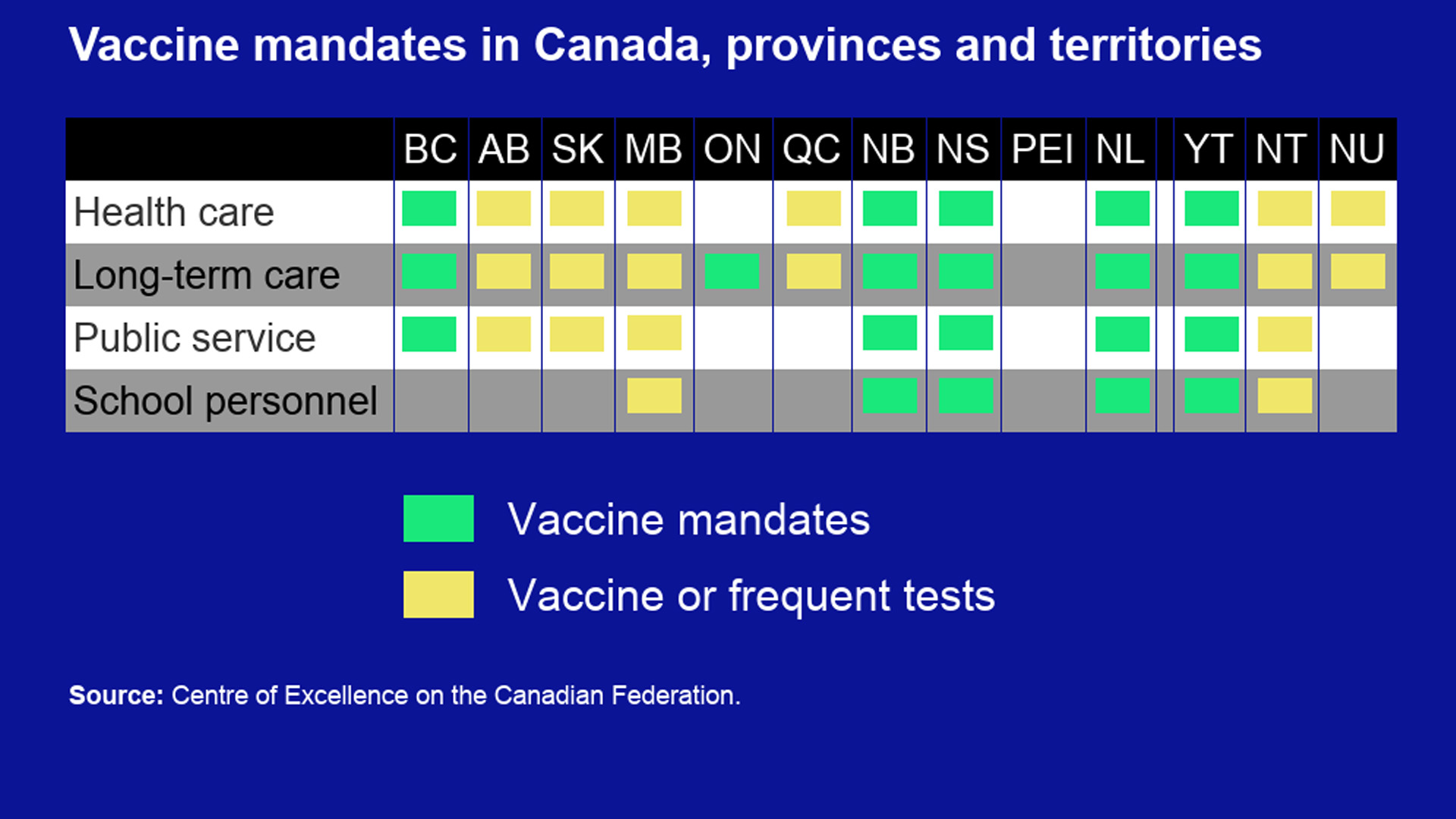
Since the first dose of the COVID-19 vaccine was administered in Canada in December 2020, vaccines have become one of the best tools available to combat the deadly pandemic. All Canadian provinces and territories now have ample access to vaccines, but each jurisdiction has chosen varying approaches to vaccination status.
Provinces and territories have had to deal with citizens who refuse to get vaccinated. As a result, governments have restricted access to certain places for unvaccinated individuals to either motivate those resistant to getting vaccinated or to protect those who have been vaccinated.
As with previous public health measures, we can use our Centre of Excellence on the Canadian Federation stringency index to identify different approaches to vaccine passports and vaccine mandates in terms of how early they were implemented, how wide-ranging they were, and how quickly provinces lift them as they ramp down measures.
Vaccine passports
The first vaccination passport was introduced by Quebec on Sept. 1, 2021, with proof of vaccination required at a range of indoor activities. In addition to being the first to introduce a vaccine passport, Quebec had the most stringent vaccine passport. Most provinces and territories have passports that apply to restaurants and bars, cultural and sporting venues, and some limited non-essential retail. However, Quebec was the only one to require it in big-box retail spaces such as Canadian Tire, Walmart and Costco. This requirement was short-lived, with Quebec announcing Feb. 15 that vaccine passports will no longer be required in big-box stores and provincial liquor and cannabis outlets.
Other provinces and territories introduced vaccination passports in mid September and late October. Figure 1 highlights the timing of the introduction of vaccine passports in terms of date of implementation and the proportion of the population who had received at least two doses of vaccine.
Importantly, not all provinces and territories currently have mandatory vaccine passports in effect. For example, Alberta’s Restriction Exemption Program (REP), was an opt-in proof of vaccination that allowed businesses to operate with fewer restrictions in exchange for participation. The REP was scrapped altogether on Feb. 9. Voluntary proof-of- vaccination programs also exist in the Northwest Territories, while Nunavut does not have a vaccine passport in place at all. British Columbia, the Yukon, the Northwest Territories, and the Atlantic provinces have not yet announced a calendar to remove the vaccine passport, something that Saskatchewan (Feb. 14), Ontario (March 1), Manitoba (March 1) and Quebec (March 14) all have done.
Mandatory vaccination in different sectors
Perhaps even more than with vaccine passports, provinces vary greatly on whether they have implemented mandatory vaccination policies. While most jurisdictions have mandatory vaccinations or testing programs for health-care and long-term care workers, there is more variance when it comes to vaccination requirements for public servants and teachers. British Columbia, New Brunswick, Newfoundland, Nova Scotia and Yukon stand out as having the most stringent vaccine mandates in the country (figure 2).
These jurisdictions do not accept regular testing as a way for the unvaccinated to keep their jobs. Without vaccination, people can be put on unpaid leave, with the possibility of permanent dismissal in some cases. Additionally, these jurisdictions, except for B.C., have vaccine requirements in place for all four sectors included in the stringency index.
The curious case of Quebec
One standout in the data is Quebec. Quebec has had many of the most stringent public health measures over this pandemic. Most notably, it was the only province to implement a curfew. It was first implemented from Jan. 9 to May 28, 2021, and then again from Dec. 31, 2021, to Jan. 17, 2022. It was the only jurisdiction to suggest a tax on unvaccinated individuals, though this idea was abandoned. Quebec has thus been willing to implement some of the harshest public health measures across Canada to contain the COVID-19 virus.
However, when we look at vaccine mandates in specific sectors, Quebec stands out by being rather timid in contrast with its other public health measures. Whereas other provinces have made vaccination mandatory in sectors ranging from the entire civil service to long-term care homes, Quebec backtracked on the only mandate it announced, for health-care workers. Instead, it subjects health-care workers to testing multiple times a week, with workers being subject to unpaid leave if they refuse to be tested. As of December 2021, approximately 458 unvaccinated health-care workers had been put on unpaid leave following a refusal to be tested.
Charter arguments will not likely help vaccine-mandate opponents
What Canada needs to consider in its plan for vaccination certificates
At the same time, Quebec has one of the highest rates of vaccination in the country. It has also been clear that masks would still be required a little longer. Masks and passports are two measures that two provinces currently fast-tracking reopenings, Saskatchewan and Alberta, are set to lift or have already lifted.
The not-so-curious case of Saskatchewan
Throughout the pandemic, Saskatchewan has had some of the lowest stringency of public health measures, as seen in figure 3.
The strategy and discourse surrounding measures have been something of an outlier in the country. Against the backdrop of Saskatchewan’s highest number of hospitalizations throughout the pandemic, Saskatchewan Premier Scott Moe announced recently that he plans to abolish all COVID-19 measures, with the province’s vaccination passport first to go on Feb. 14. Premier Moe falsely asserted in a recent message to Saskatchewan and Canadian truckers that “vaccination is not reducing transmission” despite consensus from public health experts that vaccines both reduce transmission and severe illness. Of note, Saskatchewan currently has the lowest rate of vaccination among provinces after Alberta.
As provinces and territories consider different routes out of the pandemic, we see increasingly divergent tactics to reach an endemic state. Some provinces want to lift all measures, including vaccine passports and mandates; others have announced a plan for reopening that preserves vaccine passports or masks. A mosaic of different approaches could see some emerge from the pandemic at different rates and with different results. However, the goal remains the same for all: to return to as normal as possible. What mix of policies lets us return to normal while preserving our health-care system remains a fundamental open question across Canada.











